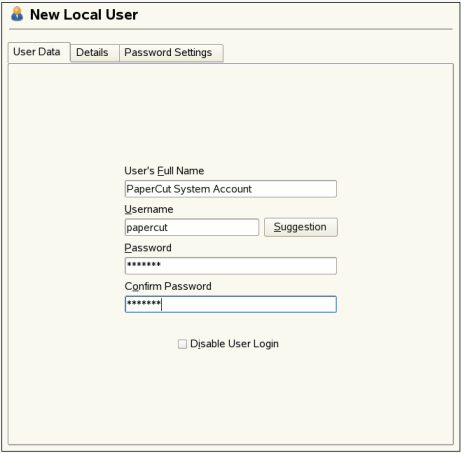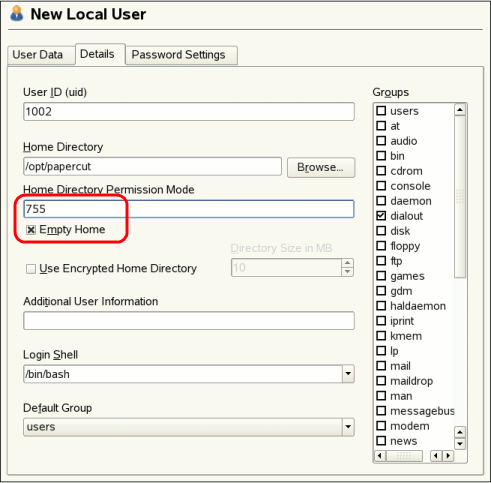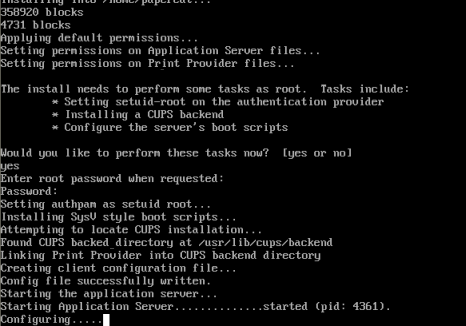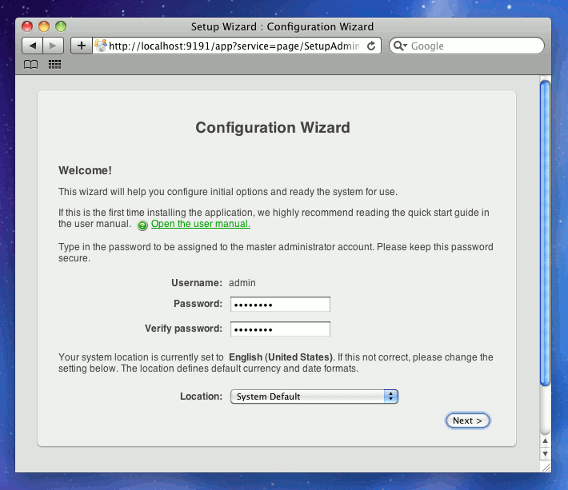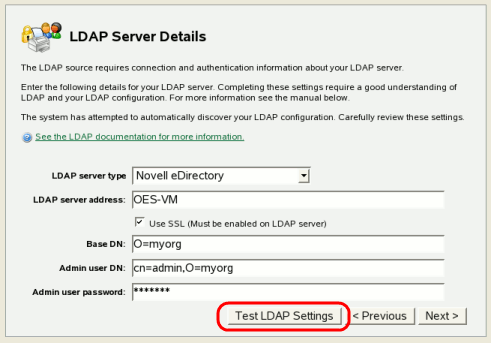Important
The following section assumes the reader has knowledge of general Novell OES Linux system management including using the command-line, creating users, editing configuration files and understanding file permissions.
Before proceeding with the installation the system administrator should take a few moments to verify system requirements. Is the operating system version supported and are patches up-to-date? Take a few minutes to verify the system is current and supported (see the section called “System Requirements”). PaperCut NG is designed to integrate with iPrint on Novell OES Linux. If your printers are currently hosted on iPrint on a Netware server or even under legacy NDPS, you will first need to migrate your queues over to a OES Linux based server. Ensure your printing is correctly working under iPrint on OES Linux before continuing to the next step.
Important: iPrint and the print queues must be configured and confirmed to work before progressing to step 2.
PaperCut NG runs and installs under a non-privileged user account called "papercut". The
papercut user's home directory location denotes the application install location.
/home/papercut is recommended, however Administrators may consider alternate
install locations depending on personal preference. Alternatives may include:
/usr/local/papercut/opt/papercut
The host user account is not an eDirectory account but a local system account. One way to create the "papercut" account on OES Linux is:
Open YaST Control Panel and select User Management under Security and Users.
Click to create a new user.
On the User Data tab, enter a username of
papercutand assign a secret password.On the Details tab, select
Empty Homewith permissions755and change theHome Directorypath to define an alternate install location.Create the account by clicking the button.
Important
This quick start guide assumes the install location is /home/papercut.
If an alternate home location is defined, some of the paths listed in subsequent sections
will require modification.
A default OES Linux installation imposes strict resource usage limits on user accounts (ulimit).
The papercut account is a special account used for hosting an application and
hence should be granted satisfactory resource limits such as the ability to open many files.
Larger sites should consider adding the following line to /etc/security/limits.conf:
papercut - nofile 65535
Novell OES Linux has a strict default firewall policy. PaperCut NG uses ports 9191 (for HTTP) and ports 9192 (for HTTPS/SSL) and these ports must be open. To open these ports:
Open YaST Control Panel and select Firewall under Security and Users.
Select Allowed Services, then click the button.
Add ports
9191and9192to the TCP Ports list (separated by spaces).Click , , then to apply the changes.
Important: Please make sure you download the correct architecture for your distribution.
i686 is for 32-bit operating systems. x64 is for 64-bit systems (also
known as x86_64 or amd64).
PaperCut NG is supplied as a self-extracting and self-installing archive. The installation is
performed under the rights of the newly created papercut account and temporary
root access will be required. Please have the root password handy. (Administrators
who are after a detailed explanation of the install process should also consult the background
information in Chapter 25, PaperCut NG on Linux).
Log on as the newly created papercut user and download and execute the installer from
the command prompt. Here is an example using wget to fetch the installer:
shell> su - papercut
shell> wget [download url from PaperCut Software website]
shell> sh ./pcng-setup-novell-oes-linux.sh
Follow the installation instructions and enter the root password when requested.
Important
Ensure you login as the user papercut so that the
user's environment is sourced and the home directory (install location) is correctly defined.
The installation process will take between two and five minutes depending on the speed of the system. A system restart is not required but administrators are advised to perform installation on live production systems during periods of low activity - for example, not during backup operations or other administration activities.
After installation, you will be prompted to open a web browser at http://[server-name]:9191/admin
to complete configuration. The configuration stages are explained below:
This is the master password for the main in-built admin account, and is independent of the operating system or domain passwords. The password will need to meet minimum strength requirements, and must be at least six characters. Ensure that knowledge of this password is kept secure. This screen also sets the system's physical location and language; ensure that these are correct before proceeding.
Tip
Treat this password like your router/modem management passwords. It is independent of your domain accounts and needs to be kept secure.
This is the organization type which matches the organizational environment where PaperCut NG will be used. Choosing the appropriate organization type will determine which system defaults are used on setup. For example, in a Professional (Client Billing) organization, where it is useful to charge-back printing to customers, an advanced client popup is provided with additional features useful for dealing with large numbers of client (shared) accounts. These default settings chosen for an organization type can be changed after installation.
This is the default cost-per-page assigned to the printers. This setting can be changed on a per printer basis after installation. Choosing a sensible cost now will help minimize future setup. For example in the USA, a value of $0.05 would be appropriate for many standard black & white printers.
When the organization type has been set to Education, users can be assigned an initial starting credit. This ensures they have funds in their account as soon as the system is enabled. An option also exists to control what happens when users run out of credit/quota. If you are evaluating PaperCut NG it might be appropriate not to disable printing when a users funds run out. This way you can be assured that user printing is not disrupted during the evaluation. These settings may be changed after setup.
PaperCut NG extracts user information out of the System or Domain. The options presented here will vary depending on the Operating System and its environment. During evaluation, most sites will opt to import all users from the system/domain into PaperCut NG. An option also exists to import a subset of users from a given group. This option is pertinent when it is known that only a subset of users will only ever use the printers.
PaperCut NG has native support for eDirectory LDAP schemas. This will be the default user import option for most sites. PaperCut NG will do it's best to auto-discover LDAP settings, but some knowledge of eDirectory and/or LDAP will be required. More information on LDAP is available in the section called “Using LDAP for user synchronization”.
In a Professional (Client Billing) environment, the main focus is on allowing users to allocate print jobs to client (shared) ccounts. The process works by:
Pausing all jobs that enter the print queues.
Displaying a popup on the user's workstation asking them to allocate the print job to an account. This is done by selecting the account from a list.
After the user has responded to the popup, the job is released to the printer.
You can read more about the account selection process and shared accounts at Chapter 8, Shared Accounts.
The account selection popup option is enabled at the user level. Once the option is enabled, the user must run the client software. If the client software is not running, the popup cannot display, and the job will remain paused in the print queue. This option is hence considered high impact. You are presented with two strategies that allow you to choose the implementation approach that best suits your needs:
In this strategy the account popup is only initially enabled on a single user for testing. You need to nominate the testing account. You may already have an appropriate test user account on your system/domain or alternatively selecting your own personal account is a good choice. The name should be in the format used to log into the domain/system (usually the short form).
The minimal impact strategy will give you time to test the popup with the nominated test user Then the Advanced account selection popup option can be enabled for other users when appropriate.
This strategy enables the account selection popup on all users. This option is good for smaller networks as it minimizes the amount of post-install configuration - just deploy the client and your up! If this option is selected you should be in a position to install the client software on user desktops as soon as possible.
If in doubt, select the minimal impact strategy. This will ensure the impact is isolated to only the nominated test user.
Prior to enabling the configuration options that you have selected, you will have the chance to verify setup options. At this stage you are still able to return to any of the prior configuration screens to alter options before clicking .
After completing the configuration wizard you will be presented with a user synchronization status screen, showing the progress and results of the system completing its initial setup. Once you have closed that, click to access the interface and begin familiarising yourself with the options and features available. Take some time to explore, and refer back to the relevant sections of this manual as required.
PaperCut NG works by directly integrating with the Novell iPrint Print Manager. iPrint must however be configured to use PaperCut NG as an accounting control source. In the current release, this configuration is done manually at the individual print queue level:
Log into iManager, expand iPrint, and select Manage Printer Manager
Select the Printer Manager associated with one of your print queues.
Click the Manage health monitor link. A list of all your printers should appear.
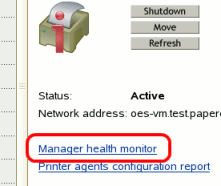
Select a Printer Agent from the list.
Click Configuration Options.
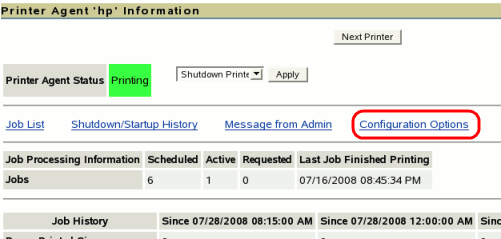
Enter
papercutunder the Accounting Autoload Command. Take care to write this all in lower case with no spaces.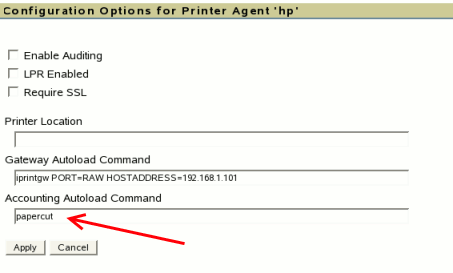
Click .
Click , then and repeat steps 4 through 7 for all printers that should be monitored/controlled by PaperCut NG
In line with best practice, backup the new printer configuration (
padbtxt.xml) as follows:In iManager open up the active Print Manager.
Select → →
Click the button .
Finally restart the Printer Manager in iManager by pressing then . After this, all jobs on the queues should be tracked.
The PaperCut NG client software is located in the local directory:
/home/papercut/client
This software needs to be shared over the network so workstations can access/install the client
application. Novell iManager provides a number of file sharing options. One simple solution is to add
a read-only NCP or Samba share called PCClient pointing to
/home/papercut/client. Established networks will benefit from ensuring the client
files are available in their Distributed Files Services. The deployment of the client software
(e.g. zero-install deployment) is covered in the section called “User Client”.
Following a fresh installation, it is highly recommended to test core features of the system. For further details please see the section called “Testing the Installation”.
NOTE: This step is a requirement for a Professional (Client Billing) installation.
Now that the system is tested and working, it is time to deploy the client software and enable the account popup for their use. It is important to deploy the client software before enabling the popup, otherwise users' printing will be stopped/paused.
As discussed earlier in the chapter the client can be run directly from a network share (which is automatically configured on Windows). There is also the option to install the software locally on each workstation, however this is not usually recommended because it makes the process of updating the client software more complicated.
Client deployment options and instruction are discussed in detail in the section called “User Client Deployment”. Follow those instructions to deploy the client software, and then enable the popup as described below.
Once the client software is deployed on user workstations, the Account Selection can be set. In a Professional (Client Billing) configuration, all users that print jobs for clients are often given the Advanced account selection popup, however, other Account Selection options may be better suited for some users based on their job function. The popup can be enabled on one user at a time or can be updated for all users in bulk. The user details page can be used to enable the popup for a single user. To enable the popup for all users in bulk:
Log into the admin interface.
Under the Users section, select the Bulk user actions... action from the menu at the top left of the Users tab.
Select the target group. To enable for all users select the
[All Users]group.In the Change account selection setting section, enable the Change account selection option.
Select the Show the advanced account selection popup option from the list.
If you do not want to allow users to charge printing to their personal account, then disable the Allow user to charge to their personal account option.
Press the OK button, and confirm the operation. Once completed, the selected users will have the account popup enabled.
Once the popup has been enabled on all users some testing should be performed from users' desktops. To test, login to the user workstation, perform a print, and check that the account popup appears and the job is logged as expected.
This concludes the Install Guide. You may like to take some time to explore the features of PaperCut NG before continuing reading at Chapter 3, Implementation by Example or Chapter 4, Quick Tour. Business users may be particularly interested in trying the popup client software as covered in the section called “Client Software”. If desired, the client software should also be deployed to other workstations. This procedure is detailed in the section called “User Client”.
To set up the optional Internet Control module, see the instructions in Chapter 15, Net Control in Detail.
